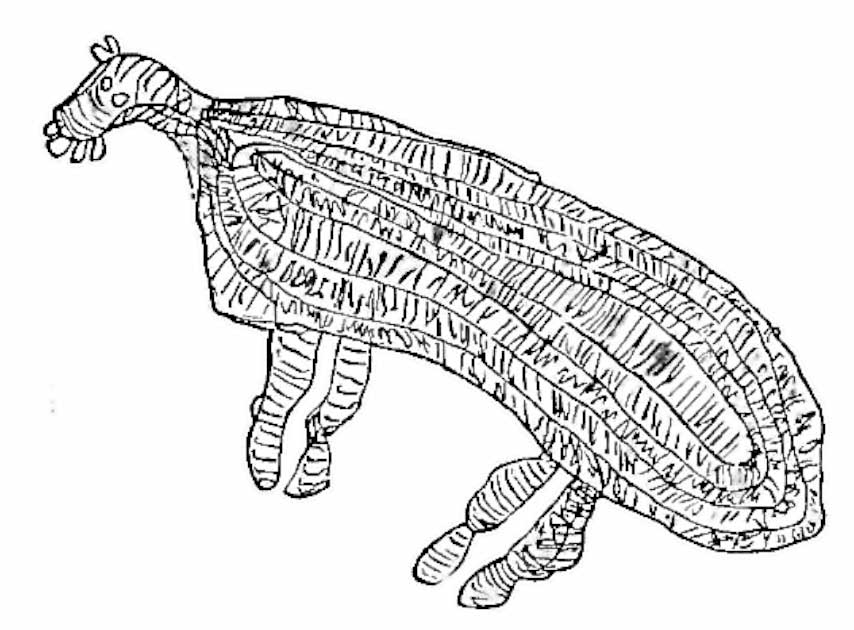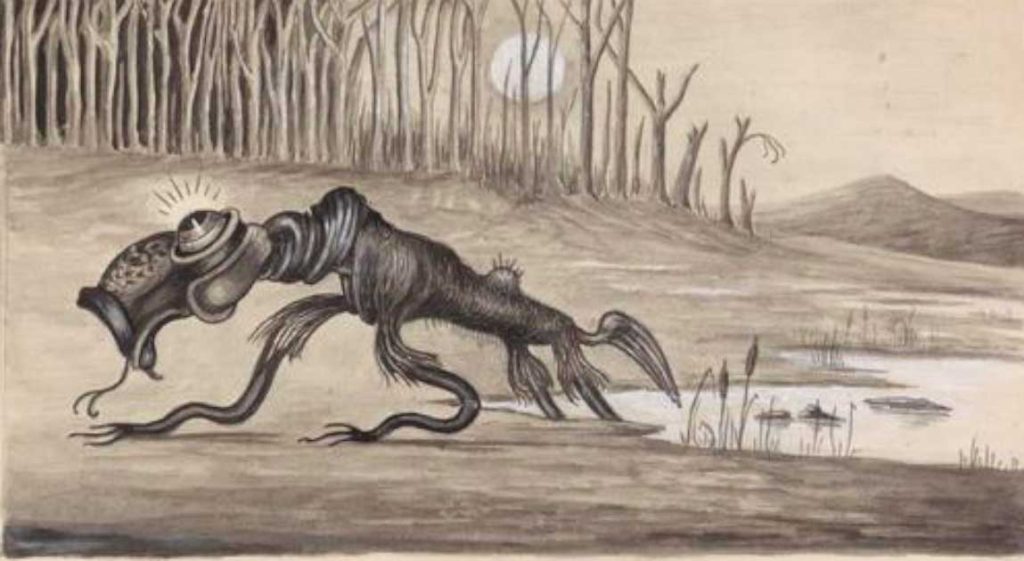The Loch Ness Monster, the Yeti, the Wendigo. Every culture has a mysterious animal that is rarely sighted but which people still believe exists. We call these creatures cryptids.
It might seem that Australia doesn’t need such a monster since it’s already full of weird and wacky creatures, but the country does have its very own unexplained monster. The Bunyip.
Originally a creature of Australian Aboriginal folklore, superstitious European settlers spent much of the 19th century looking for and “sighting” Australia’s devil spirit. What were the looking for, out there in the Aussie wilderness?
And what did they find?
What was the Bunyip?
The Bunyip was a traditional part of Australian Aboriginal myths and legends with different tribes calling it slightly different things. Today the most popular name for the beast, bunyip, can be traced back to the Wemba-Wemba language of the Aboriginal people of Victoria in South East Australia.
Today, Bunyip is usually translated as “devil” or “evil spirit”. The creature is usually described as being amphibious and living in bodies of water such as rivers, lakes, marshes, and billabongs (the Australian term for an oxbow lake).
A solid description of the Bunyip is hard to tie down and physical descriptions vary widely. For example, the Moorundi people of the Murray River describe it as a dreaded water spirit that appears in the form of a giant starfish.

On the other hand, a depiction of it carved by Aboriginal people into the bank of Fiery Creek, near Ararat Victoria, was 11 paces long and 4 paces wide, making it sound like a long, thick snake. It’s aquatic (and reclusive) lifestyle do not help things, as the animal is often only glimpsed.
Confusing things even further, the Bunyip supposedly seen by settlers doesn’t match the aboriginal descriptions at all. The most commonly referred to form of the creature resembles that of a seal or swimming dog.
- The Yowie: More Than Just Australia’s Bigfoot?
- Orang Pendek: Is There An Unknown Great Ape In Remotest Sumatra?
This form is usually described as being around 4-6 feet (1-2 meters) long with a shaggy brown or black coat. This Bunyip is said to have a round head like a bulldog’s with prominent ears and the whiskers of a seal or otter.
The second most common version of the Bunyip describes the beast as having a long neck but a small head. This version is much longer, between 5 to 15 feet (1.5- 4.5 meters) long, and like the other version is said to have black or brown fur.
The head is described as resembling that of either a horse or an emu with large ears and small tusks. The long elongated neck is maned and is several feet long. The body is made up of folds of skin and this version has a horse’s tail.
Across aboriginal stories and witness stories, the creature is said to be amphibious and nocturnal. According to folklore it has fins or flippers and is a quick swimmer. In much of the folklore, it mainly feeds on crayfish. If this sounds a little too peaceful for a devil, other legends say the Bunyip is a bloodthirsty creature that enjoys hunting women and children.
This scarier version of the Bunyip appears to have originated from Ngarrindjeri dreaming (a religious practice of the Ngarrindjeri tribe of the eastern Fleurieu Peninsula). The Ngarrindjeri describe the Bunyip as a water spirit known as the Mulyawork. It appears in cautionary tales that say the creature will take anyone who overfishes the waterways or children who get too close to the river.
Explanations for the Bunyip
Ever since 1818 when the explorers Hamilton Hume and James Meehan found large bones in a lake in New South Wales, Westerners have been trying to explain the origins of the Bunyip as a physical entity. In fact, Western settlers appear to be much more interested in the Bunyip than the Aboriginal people who created it.
A popular suggestion by Charles Fenner, an Australian geologist, naturalist, and geographer, was that the Bunyip was nothing more than a seal. Occasionally seals had a habit of making their way up the Murray and Darling Rivers. He pointed out that seals had been found as far inland as Overland Corner, Loxton, and Conargo.
When you think of the most common description of the Bunyip, Fenner’s suggestion makes a lot of sense. This description closely matches that of a seal, especially if someone hadn’t actually seen a seal before and was scared. In particular, the Bunyip resembles southern elephant seals and leopard seals, the males of which can be incredibly aggressive.
The problem is Fenner’s theory only covers the Bunyip that settlers in the 19th century claimed to have seen. It doesn’t help explain where the Aboriginal people got their Bunyip from or why their descriptions of the creature vary so widely.
- Hunting the Tikbalang, Spindly Horse Monster of the Philippines
- The Leshy: Slavic Monster that Inspired a TV Franchise
A second popular theory proposes that the Bunyip is a cultural memory of extinct Australian marsupials. This theory was first formally suggested by Dr. George Bennett of the Australian Museum in 1871.
The idea is that the Aboriginal peoples of Australia have been there for so long that their earliest ancestors lived side by side with some of these extinct creatures. As these creatures died out the stories people told of them morphed into myths and legends about the Bunyip.

In the 1990s paleontologist, Pat Vickers-Rich and geologist Beil Archbold had a similar idea. They proposed that the legends surrounding the Bunyip came from ancient aboriginals either coming across the prehistoric remains of extinct animals or even living alongside such animals. This is similar to the theory that the reason most cultures have “dragons” is that early peoples came across dinosaur bones and were unable to explain them.
Finally, an article in Australian Birdlife suggested the aboriginal version of the bunyip may have come from early encounters with the southern cassowary. These large birds match the first written description of the Bunyip, made in 1845.
This description states that the Bunyip lays massive pale blue eggs, and has deadly claws, powerful rear legs, a bright chest, and an emu-like head, all of which match the Australian cassowary to a tee. This bird’s temperament also matches that of the Bunyip, the bird is known to be highly aggressive, and territorial and largely solitary.
Many Monsters in One
There are several prominent theories attempting to explain away the Bunyip. Yet the fact is this task is next to impossible because there is not just one Bunyip. The incredibly varied descriptions of the Bunyip mean that people are probably attempting to explain several different creatures at once.
It seems most likely that the vast majority of sightings during the 19th century can be put down to elephant seals and leopard seals who had wandered upriver and inland. Most of the bones found during this period are clearly connected to extinct marsupials who once roamed prehistoric Australia.
These fossils, aligned with cultural memory, would also help explain where the myths came from in the first place. Different tribes discovered different bones of extinct creatures and combined with a millennia-old game of Chinese whispers created the Bunyip of legend.
Or, since Australia is so vast, and everything there seems designed to kill us, maybe, just maybe there is some mysterious species of monster that lurks in the lakes and billabongs. Something so terrible that it leaves those lucky enough to survive too terrified to give a coherent description. Stranger things have been found in Australia.
Top Image: Descriptions of the Bunyip vary widely, but most agree that it is aquatic, hairy, and predatory. Source: Daniel Eskridge / Adobe Stock.